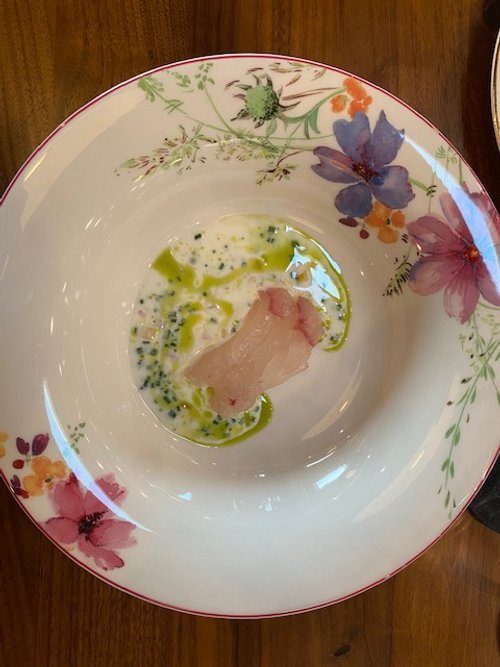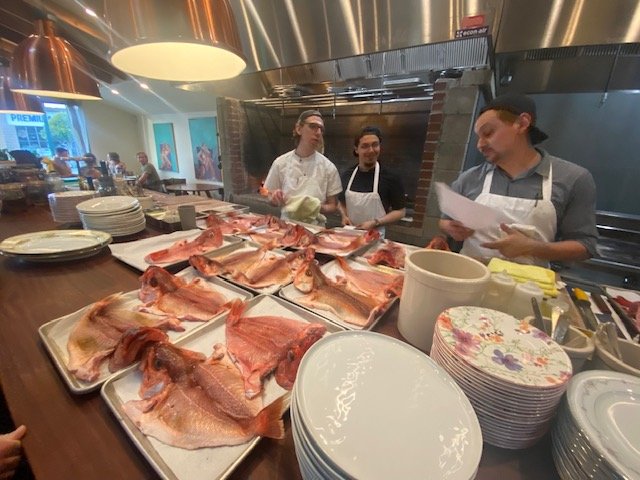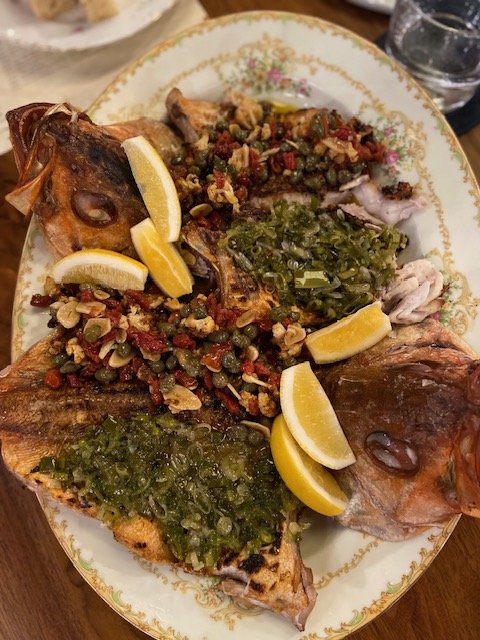Building Community - One Fish at a Time!
Fisherman Tai Huynh in Moss Landing who provides fish for the Community Seafood Program, Photo courtesy of Peter Adame and Lusamerica
The Community Seafood Program was founded amid the COVID pandemic with a win-win ambition: give local fisherfolk steady demand for their catch in unstable times, and provide those dealing with food insecurity fresh, local, nutritious fish.
Just as organizers had hoped—buoyed by local enthusiasm, community donations, the Get Hooked! dinner series and grants—the CSP win-win did manifest. To date, the program has provided 30,540 meals to those in need of food assistance.
Ocean2Table—a collective of fishermen, farmers and foragers who share local harvest with subscribers—participates on the provider side.
“Our fishermen partners are eager to have reliable nearby markets,” says O2T owner-operator Ian Cole, who notes how much domestic seafood is exported, while so much consumed in the U.S. comes from abroad. “It's nice to see your catch show up right in your neighborhood, particularly for those who need it most.”
Peter Adame collaborates with the Community Seafood Program as Sustainability Director for Lusamerica, which is rehabbing docks for fishermen and women in Moss Landing as part of its aim to provide quality regional catch for grocers, foodservice pros, and restaurants.
“It’s exciting to be working on this [because] we love the concept: Helping fishermen and helping the hungry,” he says.
Meanwhile, those served by the likes of community kitchen-pantry Pajaro Valley Loaves and Fishes are every bit as energized. Executive Director Ashley Bridges observes it up close.
“To give fresh fish out to someone who couldn’t buy it on their own is wonderful,” she says.
Other encouraging outcomes have cascaded—and keep cascading—from there, including increased nutrition, accessibility, equity, and awareness, and even an appetite for under appreciated fish. With a jolt of inspired chef-driven flavor too!
Here’s a look at those additional benefits:
Nutrition and security
Fun(ctional) fact: West Coast ground fish, a primary target for Monterey Bay fisherfolk—heightened now that salmon season is shut down indefinitely—has been shown to supply superfood-level nourishment. Exact Scientific Services Lab conducted an in-depth study that reveals just that (on behalf of Positively Groundfish), an organization building markets for ocean-floor fish now that they’re no longer red-listed.
Pacific dover sole, for instance, is a great source of vitamin E, vitamin B6 and selenium—an antioxidant mineral—while being hyper-high in protein (96 percent of its calories are protein-derived, versus 80 percent for skinless chicken breast).
Black cod (aka sablefish) packs in more omega-3 fatty acids than salmon, mackerel, sardines or anchovy, and five times more than Atlantic cod.
Pacific rockfish does its part with 92 percent of total calories coming from protein and higher levels of omega-3s than most every other lean white fish.
Those are big dietary boosts.
“Food insecurity looks different from family to family, and one way we see it is with [families] dialing back what they buy,” Loaves and Fishes’ Ashley Bridges says. “You may be giving your kids food, but the quality is what diminishes, as you’re trading in fresh protein or vegetables and buying high-calorie, high-carb prepackaged food, or frozen stuff, and calling it a meal.”
Accessibility and equity
People think of many things when Big Sur comes to mind—redwoods, rivers, coastline, condors, camping and cliffs among them.
They don’t often think food desert. But as the pandemic reminded the South Coast, there isn’t a single grocery store around Big Sur, or for roughly 70 miles between Carmel and Cambria, let alone a seafood market.
That’s where The Big Sur Big Share community food bank encountered major need during coronavirus shutdowns, serving 250 individuals weekly with donated fresh produce, pantry staples and now—in partnering with the Fisheries Trust—fresh fish.
Helen Handshy, a co-founder of the program, helps lead the Big Share effort.
“The Community Seafood Program has allowed us to share something that is hard to come by in our community,” she says. “We believe that a sustainable food system is essential to the health of a community, and the CSP and Fisheries Trust share our mission. We couldn’t be more happy with the collaboration.”
At the same time, residents in less remote places—including farmworkers working the fields that supply the entire country with greens and vegetables—also remain without avenues to afford or access nutritious fish.
“High quality protein is hard to come by,” Ocean2Table’s Ian Cole says. “It really feels great when someone takes a first bite of something caught in their backyard that they didn’t know existed.”
Appetite and awareness
Walter Deyerle and team from Sea Harvest delivering fish to Meals on Wheels of the Monterey Peninsula.
Meals on Wheels of the Monterey Peninsula Executive Chef Isaiah Cortright has been working for years with all sorts of West Coast fish at top-shelf seafood restaurants.
So it’s telling that he didn’t discover Pacific grenadier—a deep-water fish native to Monterey Bay with flaky, mild, white meat that’s delicious baked, broiled, roasted or fried—until partnering with the Community Seafood Program.
“As a new food it’s electrifying, not just nutritionally, but with the team learning about using sustainable seafood,” he says. “It’s been really fun being able to incorporate things like grenadier into meals for seniors.”
In the process of crafting dishes like grenadier piccata and Brazilian fish stew—“It’s such a delicate flavor, you don’t need to do a lot,” Cortight says—he’s also exposing local eaters to something they didn’t know was an option, which helps support the market for local fisherfolk going forward.
It also represents an important big-picture development worth broadcasting far and wide: the recovery of a previously overfished West Coast stock is thriving. “The conservation success behind ground fish needs to be shouted from the rooftop,” Lusamerica’s Peter Adame says. “Many locals haven’t tried these species.”
Flavor and revelation
On came the smoked king salmon collar, the seafood boudin sausages with Dungeness crab, rock crab, and rockfish, and abalone served in its incandescent shell with electric-orange edible flowers.
Those were the featured dishes for a Get Hooked! dinner at Big Sur Bakery in May of 2022; the same local boats that supply the seafood for area pantries also furnish the fish for many of the fundraising meals at standout local seafood-driven spots around Monterey Bay.
With each installment of the series—other dinners happened at Wild Fish in Pacific Grove and Colectivo Felix in Santa Cruz— fishermen and purveyors attend and educate diners on their practices.
Alan Lovewell of Real Good Fish speaking at the Big Sur Bakery Get Hooked dinner.
For instance, Real Good Fish founder Alan Lovewell joined the Big Sur Bakery meal, telling those in attendance, “This meal is an example of how incredible things can happen if we remember we're capable of getting back to the roots of what a fishing community can be.”
Chefs like Tim Eelman, who hosted the dinner, also weighed in.
“When you’re looking at this level of raw product and this quality of ingredients, it gets your brain firing on how well you can treat it and how far you can push yourself to let that ingredient shine,” he told diners. “It’s so prime; it’s so perfect. These people dedicate their lives to sustainably farming their abalone, to catching this fish—the least we can do as chefs is give it our all.”
The most recent Get Hooked! dinner took place at Maligne in Seaside. Chef-owner Klaus Georis and company assembled a menu of buttermilk-cured Monterey Bay halibut crudo, Dungeness crab cakes (just as the season closed) and rockfish with dueling sauces.
Moss Landing-based fisherwoman Liza Star spoke as diners settled into the spectrum of flavor.
Cue the connectivity: Monterey Bay fishing pros get to know their audience and share their craft; local seafood aficionados discover new favorite chefs, restaurants and types of fish; and resources are generated to create accessibility and mitigate local food insecurity with the fresh catch native to these shores.
Chef Isaiah Cortright digs the equal opportunity.
“When I cook with pistachio rockfish, it’s the same species from the same waters going to Pajaro Valley Loaves and Fishes as it is to the upscale restaurants,” he says. “That is a really cool thought: The program is really leveling the playing field.”
The next Get Hooked! dinner visits HOME restaurant in Soquel on June 8th, where Chef Brad Briske has long prioritized local product.
He has a number of lip-smacking courses in mind for a family-style affair preceded by a reception in the restaurant’s verdant gardens to interact with Hans Haveman, co-owner/operator of H&H Fresh Fish in Santa Cruz, where the protein will be coming from.
Briske is thinking about preparations for Monterey Bay Abalone Company’s shellfish, sea lettuce pasta with urchin, and the freshest catch possible, though he hasn’t decided whether he’ll whole-roast what comes to his kitchen, brine it, salt-crust it, make seafood sausage or—quite possibly—do all of the above.
One item he knows he will do is unprecedented, a combination of halibut ceviche, poke and crudo. “Cev-oke-udo,” he says. “That's what I've been calling it, cause it's not really any of just one of those.”
Like Briske told the Fisheries Trust last year, the collaboration on behalf of the region’s fishermen is important to him and his team. “We want to support the local community and pay [it forward],” he said. “Plus, I like the personal relationships, knowing who I’m getting it from, who shows up and stands behind it.”
Readers who don’t want miss out on this event can secure tickets for the Get Hooked! HOME edition today!
Progress and purpose
For a relatively recent undertaking, there’s a lot going on with the Community Seafood Program.
That said, a step back reveals the mission at its core is rather simple: It’s about creating and supporting community.
Cole speaks to the experience of delivering fish to donation recipients.
“Seeing the excitement when we’re dropping off at Pajaro Loaves and Fishes or Meals on Wheels reminds me why we do this,” he says. “People are there picking up lunches, and we’re dropping product that just came off the boat—something they don’t usually see—and the energy in the air is palpable: Everybody’s asking questions about where it came from, and happy to share in the passion that there are delicious and healthy options to be found right around here.”
**The Community Seafood Program partners with a number of local suppliers and food relief organizations. In addition to the ones listed above, we regularly work with Sea Harvest as a supplier of black cod and grenadier and H&H Fresh Fish, and donations are also made to the Food Bank for Monterey County and Al & Friends. Please see our website for more information on the program and each of our partners.**









